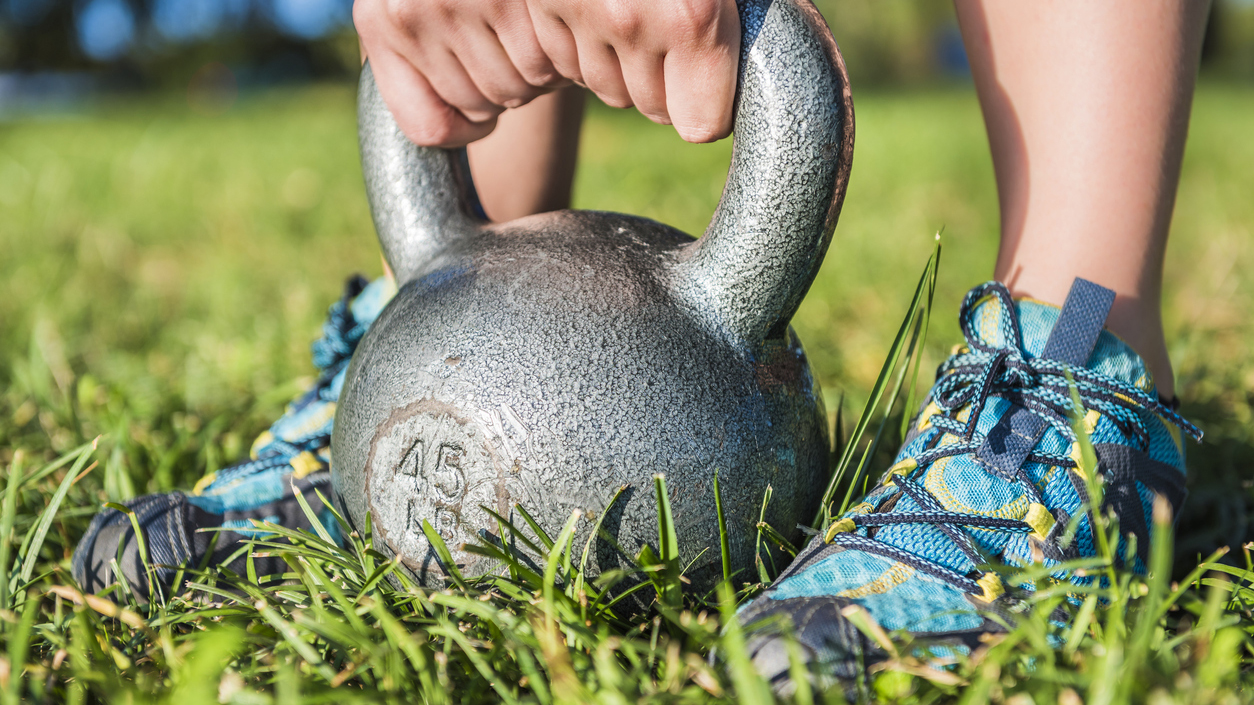5 Keys to Lacrosse Speed Training
Of all of the major sports played in this country, none features so many quick and multi-directional movements as lacrosse.
Basketball is similar, but its players’ movements are restricted by rules that can stop aggressive action (traveling, carrying, walking, etc). Football is fast and explosive, but it isn’t as dynamic in terms of change of direction.
That said, lacrosse speed training needs to develop those attributes among its players.
1. Strength As the Foundation
You have to lift. It is that simple.
Lacrosse is gaining in popularity, and we are starting to see athletes who formerly might have favored football or basketball appreciate the benefits of playing lacrosse.
With the rise in participation come athletes who are bigger, faster and stronger and who are looking to take advantage of their slower and weaker competition.
Without sufficient strength, the other attributes necessary to improve performance won’t be developed enough to take an athlete’s game up a level. Strength is truly the foundation upon which all other athletic qualities are built.
Here is a really simple A/B split program to get started strength training for maximum lacrosse speed.
|
Workout A |
Sets/Reps |
Workout B |
Sets/Reps |
|
1a) Squat Jump |
3 x 5 |
1a) Kneeling Medball Hip Toss |
3 x 6 ea |
|
3 x 8 ea |
1b) Skater Jump w/ Stick |
3 x 5 ea |
|
|
2a) Trap Bar DL |
4 x 6 |
2a) Front Squat |
4 x 6 |
|
3a) One-Arm DB Bench |
4 x 8 ea |
3a) TRX Row |
4 x 6 |
|
3b) Deadbug |
4 x 8 ea |
3b) Split Squat |
4 x 8 ea |
|
4a) Push-Up |
4 x 10 |
4a) One-Arm Row |
4 x 8 ea |
|
4b) Side Lunge |
4 x 8 ea |
4b) Plank |
4 x 20 sec |
2. Power
When you look at this program, you will notice a few things that are staples in nearly every program; but it also contains stuff that’s specific to rotational athletes like lacrosse players.
You see, power is created in all three 3 planes of motion—sagittal (forward and backwards), frontal (side to side) and transverse (rotationally). This means that in order to build more power in these movements, you need to actually train power in this way.
Although Power Cleans and Box Jumps are great power developers, it is important to add specific exercises to your training that contribute to your sport—things like Med Ball Hip Tosses and Skater Jumps, which we use to help create greater speed and movement in a more dynamic fashion.
3. Straight Speed
A few years ago, a number of strength coaches were asked what the best power exercise for athletes was.
The number one answer: sprinting
It is important to work on high effort sprints 2-3 to 4-8 times per week, depending on how you feel.
Drills like Marches, Skips, and Wall Drills, can help you acquire some of the more important fundamental skills.
An easy way to add these to your training is to incorporate them into your warm-up prior to strength training. This way, you will perform many of the movements you will later do with resistance.
4. Change of Direction
Often confused with agility, change of direction is developed using your favorite drills—cone work, 5/10/5 or Pro Agility runs, speed ladders—which teach you how to stop and change directions away from a target.
These drills are an essential component to developing all-around speed and movement.
If you train four days per week, two should be spent in multi-directional sessions and two should be spent in linear (straight ahead) speed sessions. In your two multi-directional sessions, set up drills that take 5-8 seconds to complete, and rest as long as you need to before you go again.
When you are trying to make new movements become your go-to moves in a live game, you will not learn them when you are tired. Once an athlete feels tired, he or she will revert back to the form and pattern that are most comfortable. So when training, you must go all out, then rest as long as needed. All-out effort for 15-20 minutes after a warm-up is more than enough to get better and move on to your weight training.
5. Integration
This is where all of the facets of your training should come together under an idea, rather than under any special technique or drill.
Integration of skills into on-field performance is an area of training where we at Superior Athletics feel like we do a tremendous job.
We do this in some non-traditional ways, but the number 1 way we transfer speed, power and strength into performance is through reactive methods.
Reactive methods involve variables that cause athletes to think faster—e.g., starting sprints on different stimuli, like movement of another athlete or a particular hand signal; or multi-directional drills, where there are only a few small rules and your reactions are dictated by someone else’s random movements.
We make speed and agility training look more like a competition. After you have practiced the movements in change of direction drills, your brain internalizes how to make your body react faster and respond quicker.
Reactive training brings out the best in an athlete’s ability to use the skills he or she has developed in the gym, and to showcase those skills on the field. By combining strength, power and speed in this fashion, we maximize your performance and help you dominate on the field.
RECOMMENDED FOR YOU
MOST POPULAR
5 Keys to Lacrosse Speed Training
Of all of the major sports played in this country, none features so many quick and multi-directional movements as lacrosse.
Basketball is similar, but its players’ movements are restricted by rules that can stop aggressive action (traveling, carrying, walking, etc). Football is fast and explosive, but it isn’t as dynamic in terms of change of direction.
That said, lacrosse speed training needs to develop those attributes among its players.
1. Strength As the Foundation
You have to lift. It is that simple.
Lacrosse is gaining in popularity, and we are starting to see athletes who formerly might have favored football or basketball appreciate the benefits of playing lacrosse.
With the rise in participation come athletes who are bigger, faster and stronger and who are looking to take advantage of their slower and weaker competition.
Without sufficient strength, the other attributes necessary to improve performance won’t be developed enough to take an athlete’s game up a level. Strength is truly the foundation upon which all other athletic qualities are built.
Here is a really simple A/B split program to get started strength training for maximum lacrosse speed.
|
Workout A |
Sets/Reps |
Workout B |
Sets/Reps |
|
1a) Squat Jump |
3 x 5 |
1a) Kneeling Medball Hip Toss |
3 x 6 ea |
|
3 x 8 ea |
1b) Skater Jump w/ Stick |
3 x 5 ea |
|
|
2a) Trap Bar DL |
4 x 6 |
2a) Front Squat |
4 x 6 |
|
3a) One-Arm DB Bench |
4 x 8 ea |
3a) TRX Row |
4 x 6 |
|
3b) Deadbug |
4 x 8 ea |
3b) Split Squat |
4 x 8 ea |
|
4a) Push-Up |
4 x 10 |
4a) One-Arm Row |
4 x 8 ea |
|
4b) Side Lunge |
4 x 8 ea |
4b) Plank |
4 x 20 sec |
2. Power
When you look at this program, you will notice a few things that are staples in nearly every program; but it also contains stuff that’s specific to rotational athletes like lacrosse players.
You see, power is created in all three 3 planes of motion—sagittal (forward and backwards), frontal (side to side) and transverse (rotationally). This means that in order to build more power in these movements, you need to actually train power in this way.
Although Power Cleans and Box Jumps are great power developers, it is important to add specific exercises to your training that contribute to your sport—things like Med Ball Hip Tosses and Skater Jumps, which we use to help create greater speed and movement in a more dynamic fashion.
3. Straight Speed
A few years ago, a number of strength coaches were asked what the best power exercise for athletes was.
The number one answer: sprinting
It is important to work on high effort sprints 2-3 to 4-8 times per week, depending on how you feel.
Drills like Marches, Skips, and Wall Drills, can help you acquire some of the more important fundamental skills.
An easy way to add these to your training is to incorporate them into your warm-up prior to strength training. This way, you will perform many of the movements you will later do with resistance.
4. Change of Direction
Often confused with agility, change of direction is developed using your favorite drills—cone work, 5/10/5 or Pro Agility runs, speed ladders—which teach you how to stop and change directions away from a target.
These drills are an essential component to developing all-around speed and movement.
If you train four days per week, two should be spent in multi-directional sessions and two should be spent in linear (straight ahead) speed sessions. In your two multi-directional sessions, set up drills that take 5-8 seconds to complete, and rest as long as you need to before you go again.
When you are trying to make new movements become your go-to moves in a live game, you will not learn them when you are tired. Once an athlete feels tired, he or she will revert back to the form and pattern that are most comfortable. So when training, you must go all out, then rest as long as needed. All-out effort for 15-20 minutes after a warm-up is more than enough to get better and move on to your weight training.
5. Integration
This is where all of the facets of your training should come together under an idea, rather than under any special technique or drill.
Integration of skills into on-field performance is an area of training where we at Superior Athletics feel like we do a tremendous job.
We do this in some non-traditional ways, but the number 1 way we transfer speed, power and strength into performance is through reactive methods.
Reactive methods involve variables that cause athletes to think faster—e.g., starting sprints on different stimuli, like movement of another athlete or a particular hand signal; or multi-directional drills, where there are only a few small rules and your reactions are dictated by someone else’s random movements.
We make speed and agility training look more like a competition. After you have practiced the movements in change of direction drills, your brain internalizes how to make your body react faster and respond quicker.
Reactive training brings out the best in an athlete’s ability to use the skills he or she has developed in the gym, and to showcase those skills on the field. By combining strength, power and speed in this fashion, we maximize your performance and help you dominate on the field.











